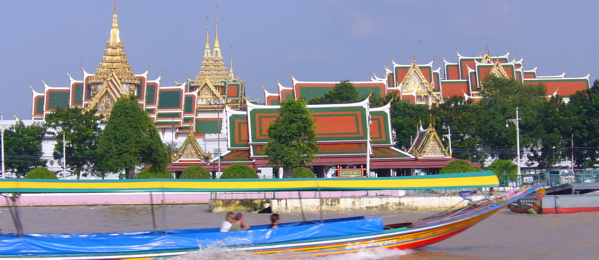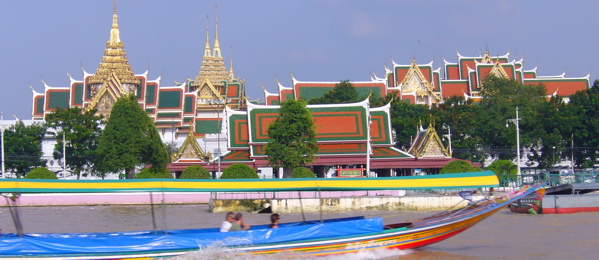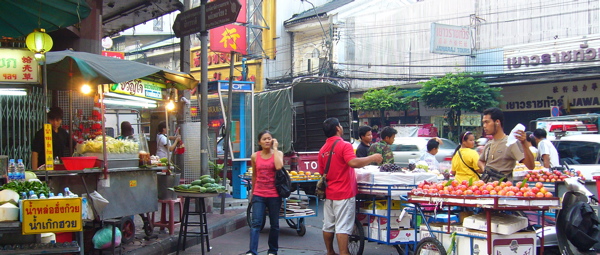Bangkok is a gritty metropolis, a hodgepodge of concrete structures, sparking temples, and disorganized dwellings. Motorcycles continuously weave between cars, smoke billows from food carts, and pedestrians meander through the commotion. Yet beneath the chaotic veneer, more serene aspects do exist, providing a welcome respite for the green-minded traveler.


Getting Around
Several eco-friendly modes of travel are possible, thanks to the efforts of environmental-minded policymakers. Taxis and buses have switched to run on liquefied petroleum gas, a cleaner alternative. Well above the frenetic streets, the electric BTS Skytrain has turned getting around in Bangkok from a sweltering nightmare into a zippy, air-conditioned ride.
Operating from 6am to midnight, the BTS stops at points along three major arteries: Sukhumvit, Silom, and Sathorn. Fares depend on distance, running up to 40 baht ($1.30) per trip. The MRT subway supplements this elevated rail, providing access to points further from the city center.
Carbon-free Activities
Bangkok air is noticeably improving, making for pleasant outdoor activities during cooler hours of the day. Suan Lumpini (MRT: Lumpini), the city’s largest park, teems with fitness fanatics. Join the locals who for free aerobics classes every evening or come early in the morning for group Sun Salutations (BYO yoga mat).
For a more leisurely pace, visit Benjakitti Park (BTS: Asok) on the grounds of the state-owned Thailand Tobacco Monopoly. Rent bikes or pedal boats, or linger in the well-kept gardens for a whiff of the sweetly pungent odor of tobacco leaf processing.
Other parks include Suan Rod Fai (MRT: Chatuchak), a former golf course and favorite venue of film crews; and the funky Suan Santi Chai Prakarn on Phra Athit Road where jugglers, breakdancers, and capoeira artists congregate.
If you have more time, take a day trip to Bang Kra Jao, a relatively unknown green area within city limits. With waterways and paths snaking through near-pristine wilderness, Bang Kra Jao is easily reached by boat. Several eco-tour operators can arrange transport and bike tours.
Temples throughout Bangkok provide a near-instant sense of peace amongst the pandemonium. Some also offer courses. Wat Mahathat on Na Phra That Road is a center for Vipassana (“Insight”) meditation study with daily classes, some in English.
At nearby Wat Po, or Temple of the Reclining Buddha, follow the stone inscriptions of yoga and massage techniques to the temple’s traditional Thai massage school. Inquire about classes or plop down on a no-frills wooden bed for a bone-crunching pressure massage (don’t worry, you’ll be fine afterwards).
Green Eats
Bangkok is famous for its street food and if you have a semi-iron stomach, taste everything, from tangy papaya salad and deep-fried grasshoppers to coconut-based sweets. Squeamish foodies need not fear, however, as fresh markets such as Or Tor Kor (MRT: Kamphaeng Phet) offer similar dishes in a clean setting.
For excellent Thai vegetarian food, visit Anotai, tucked behind a row of shophouses in Soi Rim Klong Sam Sen off Rama IX Road. Anotai serves organic vegetables from their farm outside Bangkok, soy-based “mock meats,” and homemade ice cream in flavors such as santol, custard apple, and atomic orange-colored Thai tea.
Govinda in Sukhumvit Soi 22 provides another unique vegetarian experience. In a dining room adorned with images of Krishna, Govinda serves great pizza and pasta, as well as more creative Italian stuffed “chicken,” “sausages,” and “seafood” dishes.
Near Chatuchak weekend market (MRT: Kamphaeng Phet), Santi Asok, an unconventional Buddhist sect, whips up an organic vegan buffet. Egalitarianism is paramount: communal seating is a must, food is priced at cost, and you must wash your own dishes.
Places to Crash
The Tourism Authority of Thailand has devised a green standard, the Green Leaf Certificate, for hotels particularly committed to eco-practices. From the luxurious Banyan Tree and Grand Hyatt Erawan to the more moderately priced Royal Princess, Novotel, and Imperial hotel chains, there are Green Leaf-certified rooms for many budgets.
For a homey setting, choose the family-run Old Bangkok Inn on Phra Sumen Road. Within walking distance of historic attractions and Khao San Road, the hotel’s eight rooms incorporate recycled hardwood, Thai floral themes, and family heirlooms. Showers dispense solar-heated water and the inn matches guests’ donations to various charities. Rates start at 3,190 baht ($106) per night.
For something completely offbeat, book a stay at the Atlanta Hotel in Sukhumvit Soi 2, identified by the sign “This is the place you are looking for, if you know it. If you don’t, you’ll never find it.” Rules abound at this European art deco-inspired establishment: No sex tourists, no drugs, no troublemakers, no pop music… Proclaiming a non-profit agenda, the Atlanta offers single occupancy rooms for as low as 500 baht ($17) per night.
Heads Up
From March to June, the weather can become unbearably hot and humid. Monsoons arrive in July and continue until October. From a green perspective, this is the best time to visit. Bursts of rain are typically scattered throughout the day, granting a reprieve from the heat, infusing the air with the fresh scent of damp earth (yes, even in Bangkok), and rejuvenating the city’s much-needed greenery.
Community Connection
Connect with these matador community members: AsianInsights is an expert on Bangkok and Thailand in general. Ryan Libre teaches photography workshops based in Thailand and Japan. For those interested in volunteering on an organic farm / sustainable community in Thailand, please read the following article.

